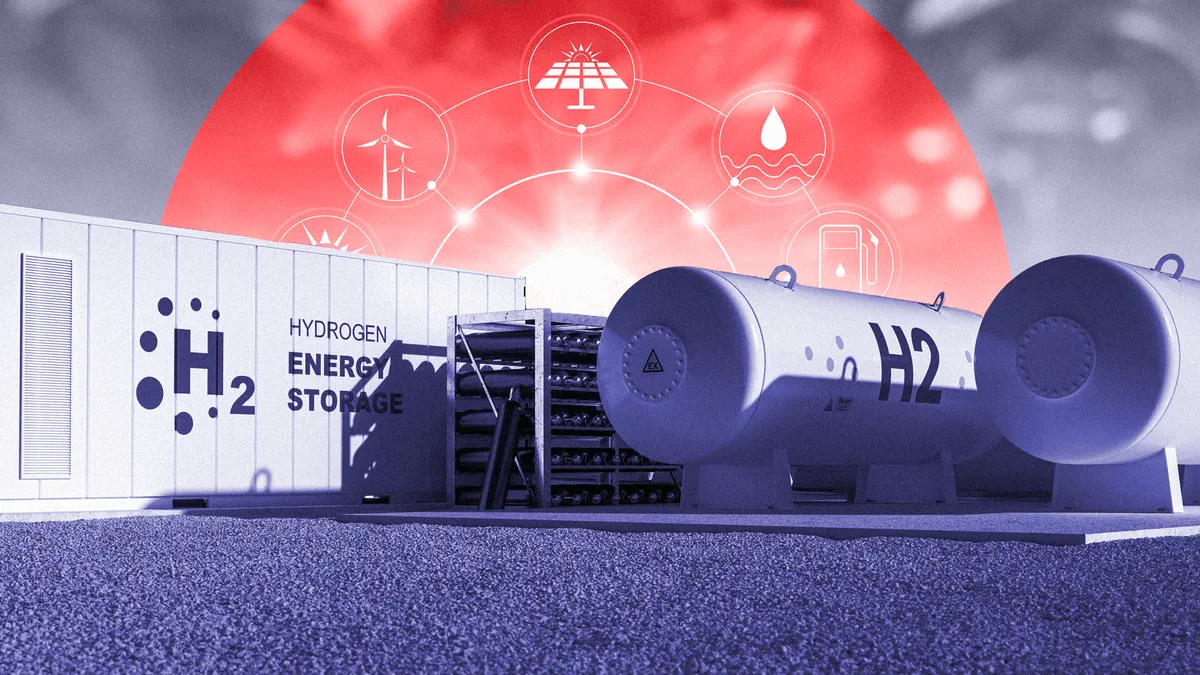Dive Brief:
- Despite significant interest in hydrogen among government and industrial leaders, securing and structuring funding for hydrogen projects remains a challenge, Frank O’Sullivan, managing director at S2G Ventures, told ACORE Finance Forum attendees during a Wednesday afternoon panel.
- Because diverse industries have taken an interest in hydrogen as a potential tool for decarbonization, expectations around how financing and offtake deals will be structured tend to vary, adding complexity to the contracting process, panelists concluded.
- Investors, too, have taken an interest in hydrogen, but many are sitting back and waiting to see how the first round of deals pan out, O’Sullivan said. “There’s no shortage of people who want to be second in this business,” he said, “but somebody’s got to be first.”
Dive Insight:
One of the greatest strengths hydrogen has to offer — its ability to be made and used in so many different ways — may also present unique obstacles as the sector seeks financing for new projects, according to participants in a Wednesday panel on hydrogen dealmaking. The forum was hosted by the American Council on Renewable Energy.
The path to getting actual hydrogen infrastructure off the ground, O’Sullivan said, is relatively clear. The capital costs associated with electrolysis are declining, and access to cheap renewable energy — cheap enough to use it to derive hydrogen from water and still sell a cost-competitive fuel — are on the horizon.
“There is a genuine road map to capital costs that are going to be quite attractive,” he said.
But the financing of these projects is particularly complex, with moving parts on both ends of the equation, according to Greg Cameron, executive vice president and chief financial officer of Bloom Energy. On one end, there’s the acquisition of energy needed to drive electrolysis. And then there are the offtakers, who may come from diverse industries with different expectations for how a contract should be structured.
The hydrogen model may feel like it could be similar to a power purchase agreement, but “it is still very nascent,” Cameron said. “There will be a performance factor, a utilization factor. What is the cost of input? You have to find investors willing to take the risk associated with that.”
Because there are so many industries looking to hydrogen as a potential carbon solution — shipping, energy and even chemicals — it’s likely there won’t be a single approach, O’Sullivan said.
“There isn’t a single model that defines, this is how the hydrogen play works,” he said. “There will be several models, and those models have not emerged yet.”
Those nations that have already begun to see hydrogen deployed at scale tend to have one thing in common, Cameron said: significant government incentives. South Korea, for example, has invested billions of dollars in standing up a hydrogen economy, he said.
“Those incentives have encouraged a lot of investment,” Cameron said. “We’re running demonstrations, 100% hydrogen fuel cells, driven not only by the investment that’s put up by them but their demand as we fulfill the road map they’ve put out.”
But industrial ecosystems also play a role, according to Mona Dajani, a partner at Pillsbury Winthrop Shaw Pittman, where she co-leads the law firm’s energy and infrastructure team and heads the renewable energy practice. Dajani noted that she has worked on a lot of deals in Denmark and Norway, where there is not only government support, but where hydrogen ecosystems are developing around shipping and industrial centers.
“We were able to work on a completely green hydrogen project taking government incentives and taking advantage of a footprint where we’re using existing infrastructure, retraining certain high-skilled workers, creating jobs and creating competitiveness for the maritime industry,” Dajani said. “And this is just an example of how there are now all these hubs around these areas, and they have very large industrial offtakers.”
The U.S. has also jumped on this model, offering $8 billion to support the creation of hydrogen hubs via the Bipartisan Infrastructure Bill. The Department of Energy outlined its initial criteria for applications for funding in a Notice of Intent released June 7.
O’Sullivan noted that this same ecosystem approach could work in the U.S in the Southwest Power Pool, where there is abundant wind energy for making green hydrogen, derived exclusively from renewable energy, and enormous demand for fertilizer, which could utilize hydrogen in the form of ammonia. The ammonia could also be sold overseas to nations like Japan, which hopes to use ammonia as a fuel to replace coal power generation.
“That means we could trade SPP wind power to Korea, to Japan,” Sullivan said. “This is an opportunity.”














